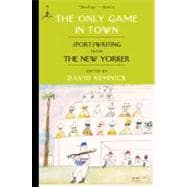
Note: Supplemental materials are not guaranteed with Rental or Used book purchases.
Purchase Benefits
What is included with this book?
| Introduction | p. xi |
| From the Bleachers | |
| The Web of the Game | p. 3 |
| Ahab and Nemesis | p. 23 |
| Hub Fans Bid Kid Adieu | p. 38 |
| The Only Games in Town | p. 52 |
| Race Track | p. 64 |
| Immortals | |
| A Sense of Where You Are | p. 99 |
| Ei Único Matador | p. 136 |
| Net Worth | p. 152 |
| The Long Ride | p. 176 |
| Born Slippy | p. 196 |
| The Chosen One | p. 209 |
| Legend of a Sport | p. 227 |
| A Man-Child in Lotusland | p. 243 |
| Personal Best | |
| Dangerous Game | p. 265 |
| The Running Novelist | p. 286 |
| Back to the Basement | p. 296 |
| Playing Doc's Games | p. 310 |
| Last of the Metrozoids | p. 325 |
| The Sandy Frazier Dream Team | p. 343 |
| A Deeper Game | |
| Br'er Rabbit Ball | p. 349 |
| The Greens of Ireland | p. 354 |
| Tennis Personalities | p. 374 |
| Project Knuckleball | p. 377 |
| Game Plan | p. 390 |
| The Art of Failure | p. 399 |
| Out of Left Field | |
| Swimming with Sharks | p. 413 |
| The National Pastime | p. 428 |
| SNO | p. 442 |
| Musher | p. 449 |
| Home and Away | p. 452 |
| No Obstacles | p. 472 |
| A Stud's Life | p. 486 |
| Table of Contents provided by Ingram. All Rights Reserved. |
The New copy of this book will include any supplemental materials advertised. Please check the title of the book to determine if it should include any access cards, study guides, lab manuals, CDs, etc.
The Used, Rental and eBook copies of this book are not guaranteed to include any supplemental materials. Typically, only the book itself is included. This is true even if the title states it includes any access cards, study guides, lab manuals, CDs, etc.